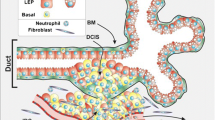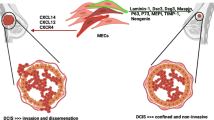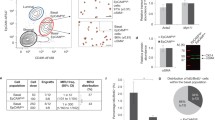Abstract
As their name implies, the myoepithelial cells found at the epithelial-mesenchymal interface of the human mammary gland disclose features suggestive of a dual epithelial-like and muscle-like differentiation, i.e. they co-express various keratins and vimentin intermediate filaments, as well as smooth muscle-related antigens. This article provides an overview of the literature on intrauterine breast development with special emphasis on the myoepithelial component of the fetal human mammary gland epithelium. It discusses original and recently published immunohistochemical data on myoepithelial precursors and reasserts the relevance of developmental, morphological fetal tissue-based studies to the understanding and the clinical management of adult diseases.
Similar content being viewed by others
Abbreviations
- αSMA:
-
alpha-smooth muscle actin
- ECM:
-
extracellular matrix
- EMA:
-
epithelial membrane antigen
- GA:
-
gestational age
- wk:
-
week
- KRT14:
-
keratin 14
- KRT17:
-
keratin 17
- KRT19:
-
keratin 19
- MMEC:
-
mammary myoepithelial cell
- PB:
-
primary bud
- PS:
-
projection stalk
- PE:
-
projection end
References
Nagato T, Yoshida H, Yoshida A, Uehara Y. A scanning electron microscope study of myoepithelial cells in exocrine glands. Cell Tissue Res 1980;209(1):1–10.
Hayward SW, Brody JR, Cunha GR. An edgewise look at basal epithelial cells: three-dimensional views of the rat prostate, mammary gland and salivary gland. Differentiation 1996;60(4):219–27.
Cardiff RD, Wellings SR. The comparative pathology of human and mouse mammary glands. J Mammary Gland Biol Neoplasia 1999;4(1):105–22.
Foschini MP, Scarpellini F, Gown AM, Eusebi V. Differential expression of myoepithelial markers in salivary, sweat and mammary glands. Int J Surg Pathol 2000;8(1):29–37.
Russo J, Russo IH. Development of the human mammary gland. In: Neville MC, Daniel CW, editors. The mammary gland. Development, regulation, and function. New York: Plenum Press; 1987. p. 67–93.
Osin PP, Anbazhagan R, Bartkova J, Nathan B, Gusterson BA. Breast development gives insights into breast disease. Histopathology 1998;33(3):275–83.
Howard BA, Gusterson BA. Human breast development. J Mammary Gland Biol Neoplasia 2000;5(2):119–37.
Hughes ESR. The development of the mammary gland. Ann R Coll Surg Engl 1949;6:99–119.
Jolicoeur F, Gaboury LA, Oligny LL. Basal cells of second trimester fetal breasts: immunohistochemical study of myoepithelial precursors. Pediatr Dev Pathol 2003;6(5):398–413.
Anbazhagan R, Nathan B, Gusterson BA. Prenatal influences and breast cancer. Lancet 1992;340(8833):1477–8.
Dabelow A. Die Milchdrüse. In: Bargmann W, editor. Handbuch der mikroskopischen Anatomie des Menschen. Vol 3. Berlin: Springer-Verlag; 1957. p. 277–485.
Vorherr H. The breast. Morphology, physiology and lactation. New York: Academic Press; 1974.
Salazar H, Tobon H, Josimovich JB. Developmental, gestational and postgestational modifications of the human breast. Clin Obstet Gynecol 1975;18(2):113–37.
Anbazhagan R, Osin PP, Bartkova J, Nathan B, Lane EB, Gusterson BA. The development of epithelial phenotypes in the human fetal and infant breast. J Pathol 1998;184(2):197–206.
Tobon H, Salazar H. Ultrastructure of the human mammary gland. I. Development of the fetal gland throughout gestation. J Clin Endocrinol Metab 1974;39(3):443–56.
Jolicoeur, F. Caracterisation de la cellule myoepitheliale du sein foetal, adulte normal et pathologique. Ph.D. thesis. University of Montreal; 2004. p. 1–206.
Naccarato AG, Viacava P, Vignati S, Fanelli G, Bonadio AG, Montruccoli G, et al. Bio-morphological events in the development of the human female mammary gland from fetal age to puberty. Virchows Arch 2000;436(5):431–8.
Pechoux C, Clezardin P, Dante R, Serre CM, Clerget M, Bertin N, et al. Localization of thrombospondin, CD36 and CD51 during prenatal development of the human mammary gland. Differentiation 1994;57(2):133–41.
Dawson EK. A histological study of the normal mamma in relation to tumour growth. Edinb Med J 1934;41:653–82.
Jolicoeur F, Seemayer TA, Gabbiani G, Robidoux A, Gaboury L, Oligny LL, et al. Multifocal, nascent, and invasive myoepithelial carcinoma (malignant myoepithelioma) of the breast: an immunohistochemical and ultrastructural study. Int J Surg Pathol 2002;10(4):281–91.
Deugnier MA, Teuliere J, Faraldo MM, Thiery JP, Glukhova M. The importance of being a myoepithelial cell. Breast Cancer Res 2002;4(6):224–30.
Williams JM, Daniel CW. Mammary ductal elongation: differentiation of myoepithelium and basal lamina during branching morphogenesis. Dev Biol 1983;97(2):274–90.
Cunha GR. Role of mesenchymal–epithelial interactions in normal and abnormal development of the mammary gland and prostate. Cancer 1994;74(Suppl 3):1030–44.
Petersen OW, Gudjonsson T, Villadsen R, Bissell MJ, Ronnov-Jessen L. Epithelial progenitor cell lines as models of normal breast morphogenesis and neoplasia. Cell Prolif 2003;36(Suppl 1):33–44.
Deugnier MA, Moiseyeva EP, Thiery JP, Glukhova M. Myoepithelial cell differentiation in the developing mammary gland: progressive acquisition of smooth muscle phenotype. Dev Dyn 1995;204(2):107–17.
Dulbecco R, Henahan M, Armstrong B. Cell types and morphogenesis in the mammary gland. Proc Natl Acad Sci USA 1982;79(23):7346–50.
Lakhani SR, O’Hare MJ. The mammary myoepithelial cell—Cinderella or ugly sister? Breast Cancer Res 2001;3(1):1–4.
Sternlicht MD, Barsky SH. The myoepithelial defense: a host defense against cancer. Med Hypotheses 1997;48(1):37–46.
Batsakis JG, el Naggar AK. Myoepithelium in salivary and mammary neoplasms is host-friendly. Adv Anat Pathol 1999;6(4):218–26.
Gudjonsson T, Ronnov-Jessen L, Villadsen R, Rank F, Bissell MJ, Petersen OW. Normal and tumor-derived myoepithelial cells differ in their ability to interact with luminal breast epithelial cells for polarity and basement membrane deposition. J Cell Sci 2002;115(Pt 1):39–50.
Gordon LA, Mulligan KT, Maxwell-Jones H, Adams M, Walker RA, Jones JL. Breast cell invasive potential relates to the myoepithelial phenotype. Int J Cancer 2003;106(1):8–16.
Foschini MP, Eusebi V. Carcinomas of the breast showing myoepithelial cell differentiation. A review of the literature. Virchows Arch 1998;432(4):303–10.
Jones C, Nonni AV, Fulford L, Merrett S, Chaggar R, Eusebi V, et al. CGH analysis of ductal carcinoma of the breast with basaloid/myoepithelial cell differentiation. Br J Cancer 2001;85(3):422–7.
Gusterson BA, Monaghan P, Mahendran R, Ellis J, O’Hare MJ. Identification of myoepithelial cells in human and rat breasts by anti- common acute lymphoblastic leukemia antigen antibody A12. J Natl Cancer Inst 1986;77(2):343–9.
Stingl J, Eaves CJ, Kuusk U, Emerman JT. Phenotypic and functional characterization in vitro of a multipotent epithelial cell present in the normal adult human breast. Differentiation 1998;63(4):201–13.
Stingl J, Eaves CJ, Zandieh I, Emerman JT. Characterization of bipotent mammary epithelial progenitor cells in normal adult human breast tissue. Breast Cancer Res Treat 2001;67(2):93–109.
Signoretti S, Waltregny D, Dilks J, Isaac B, Lin D, Garraway L, et al. p63 is a prostate basal cell marker and is required for prostate development. Am J Pathol 2000;157(6):1769–75.
O’Connell JT, Mutter GL, Cviko A, Nucci M, Quade BJ, Kozakewich HP, et al. Identification of a basal/reserve cell immunophenotype in benign and neoplastic endometrium: a study with the p53 homologue p63. Gynecol Oncol 2001;80(1):30–6.
Barbareschi M, Pecciarini L, Cangi MG, Macri E, Rizzo A, Viale G, et al. p63, a p53 homologue, is a selective nuclear marker of myoepithelial cells of the human breast. Am J Surg Pathol 2001;25(8):1054–60.
Pellegrini G, Dellambra E, Golisano O, Martinelli E, Fantozzi I, Bondanza S, et al. p63 identifies keratinocyte stem cells. Proc Natl Acad Sci USA 2001;98(6):3156–61.
Cooper D, Schermer A, Sun TT. Classification of human epithelia and their neoplasms using monoclonal antibodies to keratins: strategies, applications, and limitations. Lab Invest 1985;52(3):243–56.
Troyanovsky SM, Leube RE, Franke WW. Characterization of the human gene encoding cytokeratin 17 and its expression pattern. Eur J Cell Biol 1992;59(1):127–37.
Verheijen R, Kuijpers HJ, van Driel R, Beck JL, van Dierendonck JH, Brakenhoff GJ, et al. Ki-67 detects a nuclear matrix-associated proliferation-related antigen. II. Localization in mitotic cells and association with chromosomes. J Cell Sci 1989;92(Pt 4):531–40.
Smith GH, Chepko G. Mammary epithelial stem cells. Microsc Res Tech 2001;52(2):190–203.
Raymond WA, Leong AS. Co-expression of cytokeratin and vimentin intermediate filament proteins in benign and neoplastic breast epithelium. J Pathol 1989;157(4):299–306.
Domagala W, Striker G, Szadowska A, Dukowicz A, Harezga B, Osborn M. p53 protein and vimentin in invasive ductal NOS breast carcinoma—relationship with survival and sites of metastases. Eur J Cancer 1994;30A(10):1527–34.
Santini D, Ceccarelli C, Taffurelli M, Pileri S, Marrano D. Differentiation pathways in primary invasive breast carcinoma as suggested by intermediate filament and biopathological marker expression. J Pathol 1996;179(4):386–91.
Perou CM, Sorlie T, Eisen MB, van de RM, Jeffrey SS, Rees CA, et al. Molecular portraits of human breast tumours. Nature 2000;406(6797):747–52.
Zhang RR, Man YG, Vang R, Saenger JS, Barner R, Wheeler DT, et al. A subset of morphologically distinct mammary myoepithelial cells lacks corresponding immunophenotypic markers. Breast Cancer Res 2003;5(5):R151–6.
Petersen OW, Ronnov-Jessen L, Weaver VM, Bissell MJ. Differentiation and cancer in the mammary gland: shedding light on an old dichotomy. Adv Cancer Res 1998;75:135–61.
Ingber DE. Tensegrity: the architectural basis of cellular mechanotransduction. Annu Rev Physiol 1997;59:575–99.
Hagios C, Lochter A, Bissell MJ. Tissue architecture: the ultimate regulator of epithelial function? Philos Trans R Soc Lond B Biol Sci 1998;353(1370):857–70.
De Potter CR, Van Daele S, Van de Vijver MJ, Pauwels C, Maertens G, De Boever J, et al. The expression of the neu oncogene product in breast lesions and in normal fetal and adult human tissues. Histopathology 1989;15(4):351–62.
Author information
Authors and Affiliations
Corresponding author
Rights and permissions
About this article
Cite this article
Jolicoeur, F. Intrauterine Breast Development and the Mammary Myoepithelial Lineage. J Mammary Gland Biol Neoplasia 10, 199–210 (2005). https://doi.org/10.1007/s10911-005-9581-9
Published:
Issue Date:
DOI: https://doi.org/10.1007/s10911-005-9581-9




